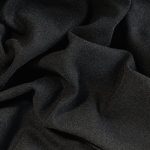You can wash jute fabric, but you need to be careful to avoid damage. Use cold or lukewarm water with mild detergent and never twist or wring the fabric to keep its shape. Avoid harsh chemicals, bleach, or machine washing, as they can weaken the fibers. Always air dry flat in a shaded area to prevent fading and mildew. Handle it gently and store it in a cool, dry place. Keep following for tips on keeping your jute items looking great.
Table of Contents
Key Takeaways
- Jute fabric can be hand washed with cold or lukewarm water using mild detergent to avoid shrinkage and damage.
- Avoid wringing or twisting jute to maintain its shape and prevent fiber distortion.
- Excess moisture causes mold or mildew; dry jute thoroughly in a well-ventilated area away from direct sunlight.
- Machine washing and harsh chemicals or bleach should be avoided to protect jute’s natural fibers.
- For routine cleaning, vacuum with a brush attachment or spot clean with a mild detergent solution instead of full washes.
Understanding the Properties of Jute Fabric
Jute fabric stands out for its natural strength and coarse texture, making it a popular choice for eco-friendly products. When you handle jute, you’ll notice it’s breathable and biodegradable, which means it breaks down easily without harming the environment.
However, it’s also prone to absorbing moisture, which can weaken the fibers and cause mildew if not dried properly. You’ll find jute is less elastic, so it doesn’t stretch much and can feel rough against the skin.
Because of its coarse weave, jute doesn’t resist dirt or stains well, so you’ll want to treat spills quickly. Understanding these properties helps you care for jute effectively, ensuring it stays durable and retains its natural charm without unnecessary damage.
Common Uses of Jute Items
You’ll find jute items popping up everywhere, from stylish home decor to trendy fashion accessories.
Its natural texture adds a rustic charm to rugs, curtains, and cushions, while also making durable bags and hats.
Let’s explore how you can use and care for these versatile jute products.
Home Decor Applications
Where can you find jute making a stylish yet sustainable impact in your home? Jute’s natural texture and durability make it perfect for a variety of home decor items.
You’ll often see jute rugs adding warmth and earthiness to living rooms or hallways. Its coarse yet soft feel also works great for curtains, offering an organic look while filtering light gently.
Consider jute cushions or poufs to introduce subtle texture and eco-friendly charm to your seating area. Jute baskets are another popular choice—they’re sturdy for storage and bring a rustic vibe to any room.
Fashion and Accessories
Beyond home decor, jute also shines in the world of fashion and accessories. You’ll find jute commonly used in bags, hats, belts, and shoes, thanks to its sturdy yet flexible nature.
When you pick up a jute tote or sling bag, you’re getting something eco-friendly and durable. Its natural texture adds a rustic charm to your outfits, perfect for casual and beachwear.
You can also spot jute in jewelry and watch straps, offering a unique, earthy vibe. While jute accessories look great, they need gentle care to maintain their shape and color.
Avoid soaking them and instead spot clean or wipe with a damp cloth. This way, your jute fashion pieces stay stylish and last longer.
Can Jute Fabric Be Washed With Water?
How should you handle washing jute fabric without damaging it?
Yes, you can wash jute fabric with water, but you need to be cautious. Jute is a natural fiber that absorbs water easily, which can weaken its structure if soaked too long.
Avoid using hot water, as it can cause shrinkage and stiffness. Instead, use cold or lukewarm water to gently clean the fabric.
Don’t wring or twist the jute, as this can distort its shape. Instead, gently blot excess water with a towel.
Keep in mind that excessive moisture can lead to mold or mildew, so drying jute quickly and thoroughly is essential.
Best Cleaning Methods for Jute Fabric
Although jute fabric is sturdy, it demands gentle cleaning methods to preserve its texture and strength. When cleaning jute, always opt for dry cleaning or vacuuming to remove loose dirt and dust.
If you must wash it, use cold water and a mild detergent, avoiding harsh chemicals or bleach. Hand washing is best—gently swish the fabric without wringing or twisting to prevent damage.
After washing, lay the fabric flat to air dry away from direct sunlight, which can cause fading or brittleness. Avoid machine washing and drying, as these can shrink or distort the fibers.
How to Spot Clean Jute Items
A quick response is key when you need to spot clean jute items.
First, gently blot the stain with a clean, dry cloth to absorb any excess liquid. Avoid rubbing, as this can push the stain deeper into the fibers.
Next, mix a small amount of mild detergent with cold water. Dampen a cloth with the solution and gently dab the stained area, working from the outside in to prevent spreading.
Mix mild detergent with cold water and gently dab the stain, starting from the outside to avoid spreading.
Use a separate cloth moistened with plain water to remove any soap residue. Blot the spot dry with a clean towel.
Always test the cleaning solution on an inconspicuous area first to verify it won’t damage or discolor the jute.
Acting quickly and carefully will help keep your jute items looking their best.
Drying Techniques for Jute Fabric
When drying your jute fabric, it’s best to air dry it to maintain its strength and texture.
Make sure to keep it out of direct sunlight, which can cause fading and brittleness.
Lay the fabric flat on a clean surface to prevent distortion and help it dry evenly.
Air Drying Benefits
Since jute fabric is naturally absorbent and delicate, air drying helps preserve its texture and strength better than machine drying.
When you air dry jute, you reduce the risk of shrinking or damaging the fibers, which can happen with the heat and agitation in dryers. Air drying also prevents the fabric from becoming stiff or brittle, keeping it soft and flexible for longer use.
To air dry, simply lay your jute item flat on a clean, dry surface or hang it in a well-ventilated area. This method allows moisture to evaporate gently, maintaining the fabric’s natural qualities.
Avoid Direct Sunlight
Air drying jute fabric works best when you avoid exposing it to direct sunlight. Direct sun can cause the fibers to weaken and fade, shortening the lifespan of your jute items.
Instead, hang or lay your jute fabric in a shaded, well-ventilated area to dry. This prevents harsh UV rays from breaking down the natural fibers. You’ll also reduce the risk of your fabric becoming stiff or brittle.
If you must dry outside, choose a spot with indirect light or dry during early morning or late afternoon when the sun is less intense.
Use Flat Surface
Although jute fabric can be hung to dry, using a flat surface helps maintain its shape and prevents stretching or warping.
After washing, gently squeeze out excess water without wringing. Lay the jute item on a clean, dry towel or mesh drying rack, spreading it evenly to avoid creases. This method supports the fabric’s natural structure and speeds up drying by allowing air circulation on both sides.
Make certain the drying area is well-ventilated but away from direct sunlight to prevent color fading. Check the fabric periodically and flip it if needed to guarantee even drying.
Using a flat surface not only preserves your jute fabric’s appearance but also extends its lifespan, keeping it sturdy and looking fresh longer.
Avoiding Damage While Cleaning Jute
When cleaning jute, you’ll want to handle it gently to prevent fraying or weakening the fibers. Avoid using harsh chemicals or bleach, as they can break down the natural fibers. Instead, opt for mild detergent and cool water.
Don’t scrub vigorously; instead, blot stains carefully with a soft cloth. Excess moisture can cause jute to warp or shrink, so steer clear of soaking it.
After cleaning, allow it to air dry flat in a well-ventilated area, away from direct sunlight. Avoid twisting or wringing the fabric, which can distort its shape.
Storing Jute Products to Maintain Longevity
Proper storage plays an essential role in keeping your jute products looking fresh and durable over time. You’ll want to avoid damp or humid places since moisture can cause mold and weaken fibers. Instead, store jute items in a cool, dry area away from direct sunlight to prevent fading and brittleness. Folding rather than hanging prevents stretching, especially for jute bags or rugs. Using breathable cotton bags or pillowcases helps protect from dust while allowing air circulation.
| Storage Tip | Why It Matters |
|---|---|
| Keep Dry | Prevents mold and mildew |
| Avoid Sunlight | Stops fading and fiber damage |
| Fold Carefully | Maintains shape |
| Use Breathable Bags | Allows airflow, blocks dust |
| Store Cool | Preserves fiber strength |
Tips for Maintaining the Natural Texture of Jute
To keep your jute’s natural texture vibrant, you’ll need to handle it gently and avoid harsh cleaning methods.
Always use a soft brush or vacuum with a brush attachment to remove dust and dirt without damaging the fibers. When cleaning spills, blot immediately with a clean cloth instead of rubbing, which can roughen the surface.
Avoid soaking jute in water; instead, spot clean with a mild detergent solution and dry thoroughly in a well-ventilated area away from direct sunlight to prevent brittleness.
Store jute items in a cool, dry place to maintain their texture and prevent mold.
Finally, avoid exposing jute to excessive moisture or heat, as these can weaken the fibers and cause stiffness, compromising the fabric’s natural feel.
Frequently Asked Questions
Can Jute Fabric Be Dyed Without Damaging Its Fibers?
You can dye jute fabric carefully without damaging its fibers by using natural or fiber-reactive dyes. Avoid harsh chemicals and excessive soaking to maintain strength and texture, ensuring vibrant color while preserving the fabric’s integrity.
Is Jute Fabric Biodegradable and Eco-Friendly?
Imagine nature’s gentle hug—jute fabric’s like that, breaking down softly, returning to earth without harm. You’ll find it’s biodegradable and eco-friendly, making it a wise choice if you want to tread lightly on the planet.
What Are the Common Pests That Affect Jute Products?
You’ll commonly find jute products affected by pests like beetles, moths, and termites. These insects love the natural fibers, so keeping your jute items dry and clean helps prevent infestations and damage.
How Does Jute Fabric Compare to Cotton in Durability?
You’ll find jute fabric less durable than cotton because it’s coarser and more prone to wear. Cotton’s softer fibers withstand frequent washing and stretching better, making it a more resilient choice for everyday use.
Can Jute Be Used for Upholstery or Heavy-Duty Applications?
Think of jute as nature’s sturdy rope—it can handle upholstery but isn’t as tough as synthetic fabrics for heavy-duty use. You’ll want to avoid high wear and moisture to keep it looking sharp and lasting longer.
- Does Chiffon Fabric Stink - July 15, 2025
- Does Chiffon Fabric Affect the Economy - July 15, 2025
- Does Cotton Fabric Have a Nap - July 15, 2025







